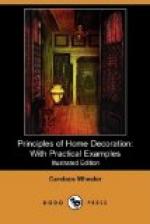One of the lessons gained by experience in treatment of house interiors, is that plain, flat tints give apparent size to small rooms, and that a satisfying effect in large ones can be gained by variation of tint or surface; also, that in a bedroom or other small room apparent size will be gained by using a wall covering which is light rather than dark. Some difference of tone there must be in large plain surfaces which lie within the level of the eye; or the monotony of a room becomes fatiguing. A plain, painted wall may, it is true, be broken by pictures, or cabinets, or bits of china; anything in short which will throw parts of it into shadow, and illumine other parts with gilded reflections; but even then there will be long, plain spaces above the picture or cabinet line, where blank monotony of tone will be fatal to the general effect of the room.
It is in this upper space, upon a plain painted wall, that a broad line of flat decoration should occur, but on a wall hung with paper or cloth, it is by no means necessary.
Damasked cloths, where the design is shown by the direction of woven threads, are particularly effective and satisfactory as wall-coverings. The soft surface is luxurious to the imagination, and the play of light and shadow upon the warp and woof interests the eye, although there is no actual change of colour.
Too much stress can hardly be laid upon the variation of tone in wall-surfaces, since the four walls stand for the atmosphere of a room. Tone means quality of colour. It may be light or dark, or of any tint, or variations of tint, but the quality of it must be soft and charitable, instead of harsh and uncompromising.
Almost the best of modern inventions for inexpensive wall-coverings are found in what are called the ingrain papers. These have a variable surface, without reflections, and make not only a soft and impalpable colour effect, but, on account of their want of reflection, are good backgrounds for pictures.
In these papers the colour is produced by a mixture in the mass of paper pulp of atoms of varying tint, which are combined in the substance and make one general tint resulting from the mixture of several. In canvases and textiles, which are a more expensive method of producing almost the same mixed effect, the minute points of brilliance of threads in light and darkness of threads in shadow, combine to produce softness of tone, impossible to pigment because it has but one plain surface, unrelieved by breaking up into light and shadow.
Variation, produced by minute differences, which affect each other and which the eye blends into a general tone, produce quality. It is at the same time soft and brilliant, and is really a popular adaptation of the philosophy of impressionist painters, whose small dabs of pure colour placed in close juxtaposition and fused into one tone by the eye, give the purity and vibration of colour which distinguishes work of that school.




